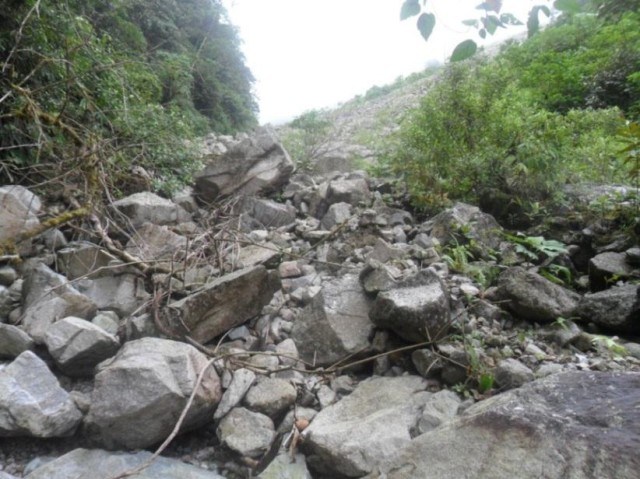6 April 2017
A tragedy foretold? The Mocoa landslide was anticipated in 2014
Posted by Dave Petley
A tragedy foretold? The Mocoa landslide was anticipated in 2014
In Colombia, the authorities are now shifting from rescue to recovery in the aftermath of the Mocoa landslide. The government has ordered a formal inquiry into the landslide, and the events that led to it, amongst claim and counter-claim about the importance of deforestation and cultivation in the destabilisation of land. A good article in New Scientist covers many of these aspects. This draws attention in particular to an article that was published in a local newspaper in 2014, written by Jorge Kuaran from the National College of Journalists. This article, which is in Spanish, appears to have been accessed so many time in the last 24 hours that the site has exceeded its bandwidth, but an archive is available on the Wayback Machine. It is a really fascinating piece that highlights the dangers of the gully that runs through Mocoa, in the aftermath of a false alarm in the town. This is a corrected Google Translation from the original Spanish:
Stories like the one of Armero, could be repeated in Mocoa, capital of Putumayo; But this time it would not be the fault of the nature, but of the lack of responsibility of the people who hold the authority in the municipality and the department. Nature, after all, has been warning and announcing a tragedy for more than two years.
The article provides additional detail about the concerns, which centre around landslides that have both blocked the channel and accumulated debris that can be mobilised into a debris flow:
Thanks to the evidence obtained by www.notifronteras.com , through the same officials of the municipal administration, it can be observed that on the Quebrada La Taruca located to the north-west of the urban area of Mocoa, and that borders with the basin of the ravine El Conejo, there has been a slide of stone, plant material, soil and other materials, about 150 meters wide by 300 meters high, which is on the channel of the ravine La Taruca … This implies by simple reasoning that the area where the great amount of material of the slip is located, has highly unstable ground by the groundwater that runs and that at any moment can generate an avalanche of proportions unimaginable given the topography of the land, that has a quite steep slope, since the head of the ravine starts more or less to a height of the 1,700 m and arrives at Mocoa that is located to a height of about 600 m with a distance of the head of the ravine to the urban area of about 7 kilometers, which means that when an avalanche is formed at the site of damming and sliding, by the force that the mass movement takes, it can reach Mocoa in less than 20 minutes, no Giving time to organize any massive evacuation of the families bordering the basin of the Taruca creek and the Sangoyaco river.
The article includes images and even videos of the debris choking the channel down which the Mocoa landslide flowed:

Debris in the La Taruca channel that was the source of the Mocoa landslide, via Jorge Kuaran
.
This is a chilling prediction of what appears to have happened. Jorge Kuaran is clear about the risk to the people of Mocao:
A tragedy of the proportions that we imagine has at risk the life of a large number of [people from Mocoa], since there are many neighborhoods or urban population living on the banks of the Sangoyaco river…I see a nonexistent emergency plan nor measures to overcome a catastrophe of considerable magnitude, it is necessary for the authorities of the municipality and the department of Putumayo to take serious steps in this regard.
Meanwhile, Mongabay has a good article (also in Spanish) that examines the causes of the Mocoa landslide disaster. This includes the following image of the catchment upstream of Mocoa, which supports the idea that this disaster was caused by shallow landslides that became a channelised debris flow:

Shallow landslides upstream of Mocoa, via Mongabay and Corpoamazonía.
.
The scale of this disaster is now becoming clear – the number of bodies recovered is now known to be 293, with 314 people believed to be missing. This would lead to a total of 607 fatalities.


 Dave Petley is the Vice-Chancellor of the University of Hull in the United Kingdom. His blog provides commentary and analysis of landslide events occurring worldwide, including the landslides themselves, latest research, and conferences and meetings.
Dave Petley is the Vice-Chancellor of the University of Hull in the United Kingdom. His blog provides commentary and analysis of landslide events occurring worldwide, including the landslides themselves, latest research, and conferences and meetings.
Dear Professor Petley,
My name is Helbert Garcia, geologist from the Colombian Geological Survey.
I’m writing this message because I would like to share with you some information about the Mocoa landslide.
We are working on the characterization of the event and it would be great if we could share and analyze some ideas about the causes and future scenarios for Mocoa.
I know your time is gold so I appreciate any reply. Feel free to contact me.
e-mail: [email protected]
Regards !